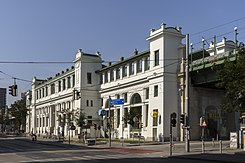Währinger Straße underground station
| Währinger Strasse Volksoper | |
|---|---|
| Underground station in Vienna | |

|
|
| The east facade, in the background the AKH | |
| Basic data | |
| District : | Alsergrund |
| Coordinates : | 48 ° 13 '32 " N , 16 ° 20' 58" E |
| Opened: | Steam light rail 1898, electric light rail 1925, underground 1989 |
| Tracks (platform): | 2 ( side platform ) |
| use | |
| Subway line : |
|
| Transfer options : | 40 41 42 40A N41 N8 |
The Währinger Straße – Volksoper station is a stop on the Vienna underground line U6 in the 9th district of Alsergrund , on the border with the 18th district of Währing . It extends along the Währinger belt between the intersections with Währinger Straße and Gentzgasse.
history
The construction of the structure was completed in December 1895 and opened on June 1, 1898 for the Vienna steam light rail . Like the other buildings of the Stadtbahn, the station was designed by Otto Wagner on behalf of the Commission for Transport Systems in Vienna . In 1918 it had to be closed due to the rampant lack of coal, before it went back into operation in 1925 for the Vienna Electric Light Rail , now owned by the municipality . Between 1925 and 1989 the light rail lines G and GD stopped here, and until 1945 also the mixed-service line 18G . On October 7, 1989, the U6 trains served Währinger Straße for the first time.
The stop received the addition “Volksoper” as a result of the takeover of the opera house by the municipality of Vienna in 1938. The addition is not yet included in the network plan from June 1939, but it is already included in the network plan from July 1939. From 1941 the addition was alternatively Städtische Oper , from 1947 State Opera (Volksoper) and from November 1959 again Volksoper . In the 1980s, the stop also lost its operational abbreviation WS from steam light rail times and was alternatively assigned the new abbreviation WA.
description

The reception building is designed as a high station and, with its rich decorations and columns at the entrance, is one of the best-preserved stations of the former light rail. The bridges over Währinger Strasse, which are south of the station, but no longer part of the station structure, and the extensions of Fuchsthallergasse and Schulgasse with their pylons and rich architectural decorations also contribute to the overall impression. The station is accessed from the east and west via open staircases and the typical green-painted swing doors . From the reception hall with its barrel vault adorned with exposed bricks, passengers use staircases to get to the two directional platforms. These were extended by a few meters on the north side in the course of the renovation for the needs of the subway operations in the 1980s in order to make room for the long trains. The access to the (retrofitted) elevators is outside of the reception building.
In the northern part of the station building there is a Billa branch, in the southern part there is a set depot and a rehearsal stage for the nearby Volksoper . There is a tobacco shop next to the western exit. The station is the highest of the historical high stations on the former light rail and today's U6.
Tram and bus
At the western exit, an operating track leads to the Gürtel depot. Trains from tram lines 40 and 41 stop here, and from 1907 to 1989 there was a stop on line 8. The bus line 40A also stops here in the direction of Schottentor , the stop in the direction of Döblinger Friedhof is further north. The bus stop for lines 40 and 41 is located south of the station, under the U6 bridge over Währinger Straße. Under the bridge over Schulgasse, line 42 stops in the direction of Antonigasse, around the corner on the Währinger Gürtel in the direction of Schottentor.
Web links
Individual evidence
- ^ Otto Antonia Graf: Otto Wagner. 1: The Architect's Work 1860–1902. 2nd Edition. Böhlau, Vienna 1994, pp. 134–248.
- ^ Alfred Horn: Wiener Stadtbahn. 90 years of light rail, 10 years of underground. Bohmann-Verlag, Vienna 1988, ISBN 3-7002-0678-X , p. 171.
- ↑ Line 8
| Previous station | Vienna subway | Next station |
|---|---|---|
|
Michelbeuern - AKH ← Siebenhirten |
|
Nussdorfer Strasse Floridsdorf → |
